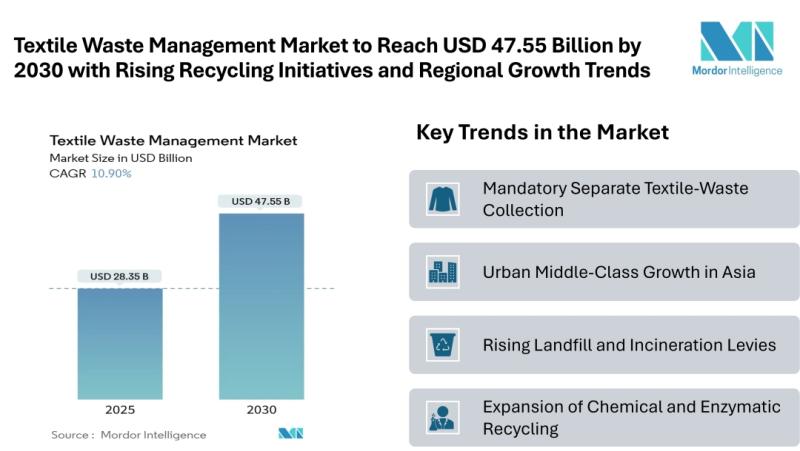Textile Waste Management Market to Reach USD 47.55 Billion – openPR.com

Report on the Global Textile Waste Management Market and its Alignment with Sustainable Development Goals
Market Overview and Growth Projections
The global Textile Waste Management Market is projected to experience significant growth, aligning with global efforts to achieve Sustainable Development Goals (SDGs). According to a report by Mordor Intelligence, the market is valued at USD 28.35 billion in 2025 and is forecast to reach USD 47.55 billion by 2030, expanding at a Compound Annual Growth Rate (CAGR) of 10.90%. This expansion is directly linked to the implementation of policies and practices supporting SDG 12 (Responsible Consumption and Production), driven by increased regulatory frameworks and heightened consumer and manufacturer awareness of sustainability.
The Asia-Pacific region currently leads the market, a consequence of its large-scale garment manufacturing industry. This highlights a critical opportunity to integrate circular economy principles and advance SDG 12 within global supply chains.
Key Market Drivers and their Contribution to SDGs
Mandatory Separate Textile Waste Collection
Government regulations in regions like the European Union, Japan, and South Korea mandating the separate collection of textile waste are a primary market driver. This policy directly supports:
- SDG 12 (Responsible Consumption and Production): By diverting textiles from landfills and facilitating recycling and reuse, these mandates promote circular material flows.
- SDG 11 (Sustainable Cities and Communities): Effective waste management systems are crucial for creating sustainable urban environments, and separate collection improves the efficiency of municipal solid waste management.
Urbanization and Middle-Class Growth in Asia
Rapid urbanization and rising incomes in Asian nations such as Bangladesh, Vietnam, and Indonesia are leading to increased textile consumption and subsequent waste generation. The development of formalized collection networks in response to this trend contributes to:
- SDG 8 (Decent Work and Economic Growth): The establishment of collection and sorting infrastructure creates local employment opportunities.
- SDG 12 (Responsible Consumption and Production): Formalized systems improve the efficiency of waste collection, which is the first step toward large-scale recycling and waste reduction.
Rising Landfill and Incineration Levies
Increasing fees for landfill and incineration in Europe and North America create a strong economic incentive for municipalities and businesses to adopt more sustainable waste management practices. This financial pressure accelerates progress toward:
- SDG 13 (Climate Action): Diverting textile waste from landfills reduces methane emissions, a potent greenhouse gas.
- SDG 12 (Responsible Consumption and Production): Higher disposal costs make recycling and reuse more financially viable, encouraging investment in circular solutions.
Technological Advancements in Recycling
The expansion of chemical and enzymatic recycling technologies offers innovative solutions for processing textile waste that cannot be mechanically recycled. This focus on innovation is vital for:
- SDG 9 (Industry, Innovation, and Infrastructure): The development and scaling of advanced recycling technologies represent a significant industrial innovation that builds resilient and sustainable infrastructure for waste management.
- SDG 12 (Responsible Consumption and Production): These technologies enable the recovery of high-quality fibers from post-consumer textiles, closing the loop and reducing the industry’s reliance on virgin resources.
Market Segmentation Analysis
By Waste Source:
- Pre-consumer (Manufacturing Scrap)
- Post-consumer (Used Garments & Household Textiles)
By Waste Type:
- Natural Fibers (Cotton, Wool, Silk, Others)
- Synthetic Fibers (Polyester, Nylon, Others)
- Cellulosic & Regenerated Fibers (Viscose/Rayon, Lyocell/Modal)
- Blended Fabrics
- Hazardous / Contaminated Textiles
By Service:
- Collection & Logistics
- Sorting & Grading
- Recycling (Mechanical, Chemical/Enzymatic, Reuse)
- Energy Recovery (Incineration & Waste-to-Energy)
- Landfill / Open Dumping
By End-User:
- Residential / Household
- Commercial & Institutional (Retail, Hospitality)
- Industrial Manufacturing (Apparel & Footwear)
- Others (Municipal Garbage, Medical Facilities, etc.)
By Geography:
- North America (United States, Canada, Mexico)
- South America (Brazil, Argentina, Rest of South America)
- Europe (Germany, France, United Kingdom, Italy, Spain, Rest of Europe)
- Asia-Pacific (China, Japan, India, Bangladesh, South Korea, Rest of Asia-Pacific)
- Middle East and Africa (Saudi Arabia, UAE, Turkey, South Africa, Rest of MEA)
Leading Organizations and their Role in the Circular Economy
Key market players are actively contributing to a circular economy and the achievement of SDG 12 through innovation and service provision:
- Worn Again Technologies: Focuses on advanced chemical recycling to separate and recapture polyester and cellulose from textiles, creating a circular resource model.
- Boer Group: Provides comprehensive collection, sorting, and recycling services, building the logistical infrastructure necessary for a circular textile economy.
- Pistoni S.r.l: Specializes in mechanical recycling, transforming textile waste into raw materials for new manufacturing processes.
- Renewcell AB: Innovates in chemical recycling to produce high-quality recycled pulp from textile waste for new garment production.
- Veolia Environnement S.A.: Offers integrated waste management solutions, including collection, recycling, and waste-to-energy, contributing to broader sustainable waste management goals.
Conclusion: Future Outlook and SDG Alignment
The Textile Waste Management Market is poised for continued growth, fundamentally driven by the global imperative to achieve sustainability. The market’s trajectory is inextricably linked to the advancement of SDG 12 (Responsible Consumption and Production), supported by regulatory action, technological innovation, and a collective shift toward circular economic principles. Market participants who invest in integrated and innovative solutions for collection, sorting, and advanced recycling will be best positioned to capitalize on this trend while contributing to a more sustainable and resource-efficient future.
Analysis of Sustainable Development Goals in the Article
1. Which SDGs are addressed or connected to the issues highlighted in the article?
The article on the Textile Waste Management Market addresses several Sustainable Development Goals (SDGs) by focusing on the economic, social, and environmental aspects of managing textile waste. The primary SDGs connected to the article’s content are:
- SDG 12: Responsible Consumption and Production: This is the most central SDG, as the entire article revolves around managing waste generated from the production (pre-consumer) and consumption (post-consumer) of textiles. It emphasizes shifting from linear “take-make-dispose” models to circular ones through recycling and reuse.
- SDG 11: Sustainable Cities and Communities: The article connects textile waste management to urbanization. It mentions “Urban Middle-Class Growth in Asia” and the role of “municipalities” in waste collection and management, highlighting the challenge of managing increasing waste in densely populated areas.
- SDG 9: Industry, Innovation, and Infrastructure: The text highlights the role of technological advancement in improving waste management. It discusses the “Expansion of Chemical and Enzymatic Recycling” and names innovative companies like “Worn Again Technologies” and “Renewcell AB” that are developing advanced technologies to create circular solutions.
- SDG 8: Decent Work and Economic Growth: The article frames textile waste management as a significant and growing economic sector. It provides data on market size and growth (“forecast to reach USD 47.55 billion by 2030”) and notes that “formalized collection networks improve efficiency and support local job growth.”
2. What specific targets under those SDGs can be identified based on the article’s content?
Based on the issues discussed, several specific SDG targets can be identified:
- Target 12.5: By 2030, substantially reduce waste generation through prevention, reduction, recycling and reuse.
- Explanation: The article’s core focus is on the growth of the textile waste management and recycling market. It explicitly discusses services like “Recycling (Mechanical, Chemical/Enzymatic, Reuse)” and trends such as “Mandatory Separate Textile-Waste Collection” which are direct strategies to achieve this target by diverting waste from landfills.
- Target 11.6: By 2030, reduce the adverse per capita environmental impact of cities, including by paying special attention to air quality and municipal and other waste management.
- Explanation: The article points to “Rapid urbanization” as a driver of increased textile waste. It discusses how “municipalities and businesses” are moving toward recycling due to “Rising Landfill and Incineration Levies,” directly addressing the challenge of municipal waste management in urban settings.
- Target 9.4: By 2030, upgrade infrastructure and retrofit industries to make them sustainable, with increased resource-use efficiency and greater adoption of clean and environmentally sound technologies and industrial processes.
- Explanation: The article highlights the “Expansion of Chemical and Enzymatic Recycling” as a key trend. It mentions companies like “Worn Again Technologies” and “Renewcell AB” that are pioneering “advanced recycling technologies” to create “circular solutions for the fashion industry,” which aligns with upgrading industrial processes to be more sustainable.
- Target 8.3: Promote development-oriented policies that support productive activities, decent job creation, entrepreneurship, creativity and innovation.
- Explanation: The article notes that in Asia, the growth of “formalized collection networks” helps “support local job growth.” This shows that the expansion of the waste management industry contributes directly to job creation.
3. Are there any indicators mentioned or implied in the article that can be used to measure progress towards the identified targets?
Yes, the article contains several quantitative and qualitative indicators that can be used to measure progress:
- Market Size and Growth Rate: The article states the textile waste management market is projected to grow from “USD 28.35 billion in 2025” to “USD 47.55 billion by 2030” at a “CAGR of 10.90%.” The growth of the separate Textile Recycling Market (projected to reach “USD 10.48 billion by 2030”) is also mentioned. These figures serve as direct economic indicators for the expansion of recycling infrastructure and services (Target 12.5 and 9.4).
- National Policies and Regulations: The mention that “Governments in the EU, Japan, and South Korea mandate separate textile-waste collection” is a policy-based indicator. The implementation and enforcement of such regulations measure progress towards systematic waste reduction and management (Target 12.5 and 11.6).
- Economic Instruments for Waste Reduction: The article points to “Higher landfill and incineration fees in Europe and North America” as a driver for recycling. The level and application of these levies can be used as an indicator of economic incentives designed to reduce landfilling (Target 12.5).
- Adoption of Advanced Technologies: The “Expansion of Chemical and Enzymatic Recycling” is a technological indicator. Tracking the investment in and operational capacity of these advanced recycling facilities measures the industry’s shift towards more sustainable and efficient processes (Target 9.4).
- Job Creation in the Sector: The statement that formalized collection networks “support local job growth” is a qualitative social indicator. This can be quantified by tracking the number of jobs created in waste collection, sorting, and recycling industries (Target 8.3).
4. Table of SDGs, Targets, and Indicators
| SDGs | Targets | Indicators Identified in the Article |
|---|---|---|
| SDG 12: Responsible Consumption and Production | 12.5: Substantially reduce waste generation through recycling and reuse. |
|
| SDG 11: Sustainable Cities and Communities | 11.6: Reduce the adverse per capita environmental impact of cities, including waste management. |
|
| SDG 9: Industry, Innovation, and Infrastructure | 9.4: Upgrade industries to make them sustainable and adopt clean and environmentally sound technologies. |
|
| SDG 8: Decent Work and Economic Growth | 8.3: Promote policies that support decent job creation. |
|
Source: openpr.com
What is Your Reaction?
 Like
0
Like
0
 Dislike
0
Dislike
0
 Love
0
Love
0
 Funny
0
Funny
0
 Angry
0
Angry
0
 Sad
0
Sad
0
 Wow
0
Wow
0
















































:focal(1500,1000)/https://media.globalcitizen.org/a6/9a/a69a4720-d8a1-4715-b596-18738d03c05c/rotary_polio_hero_image.jpg?#)







/countries/sri-lanka/photo-credit---dmc-sri-lanka.tmb-1200v.jpg?sfvrsn=dc298bcc_1#)



















